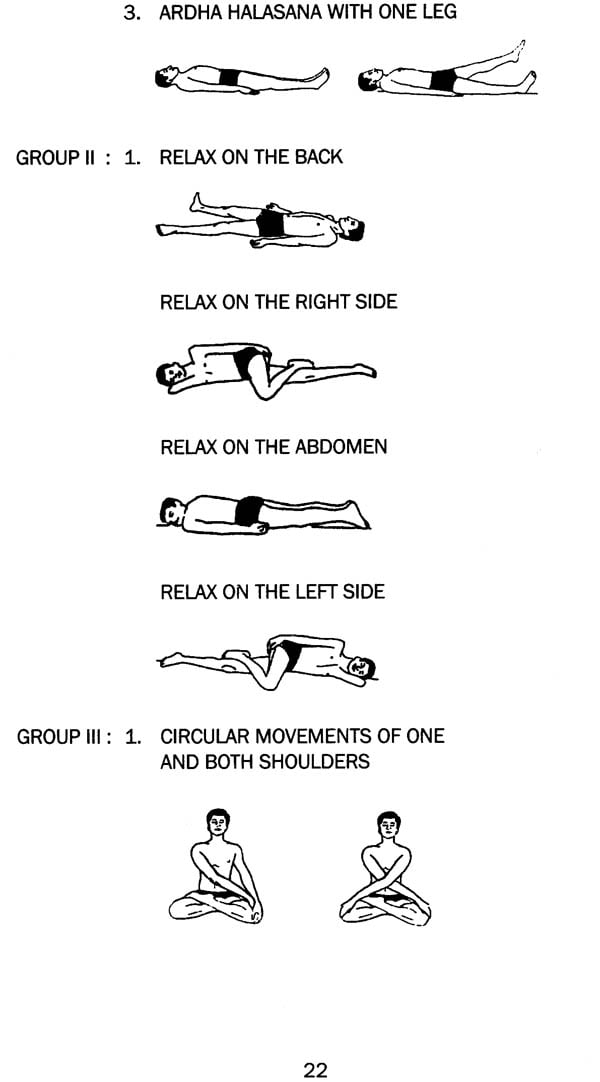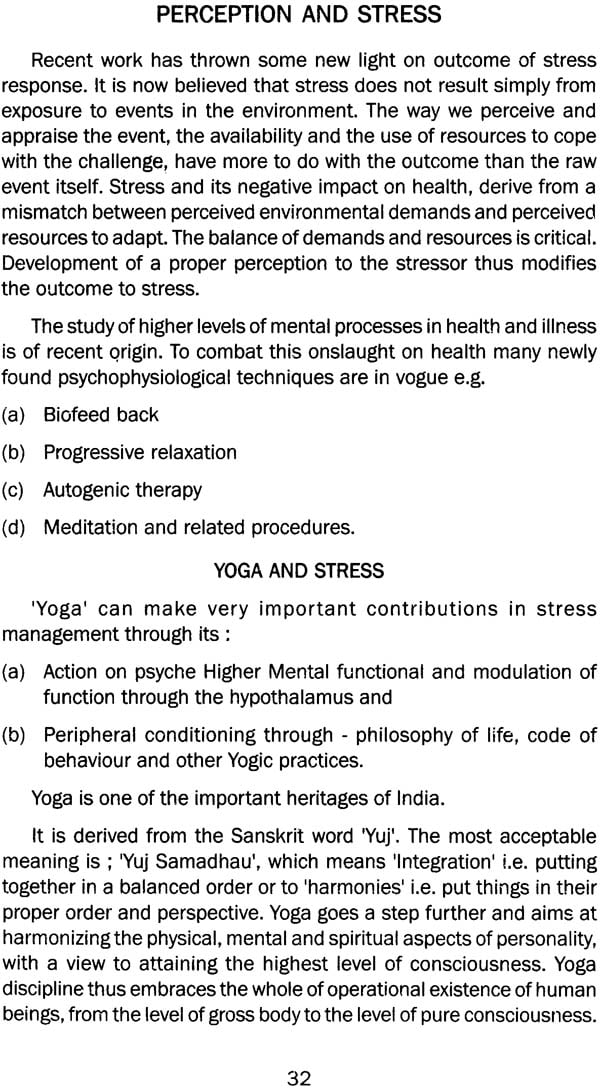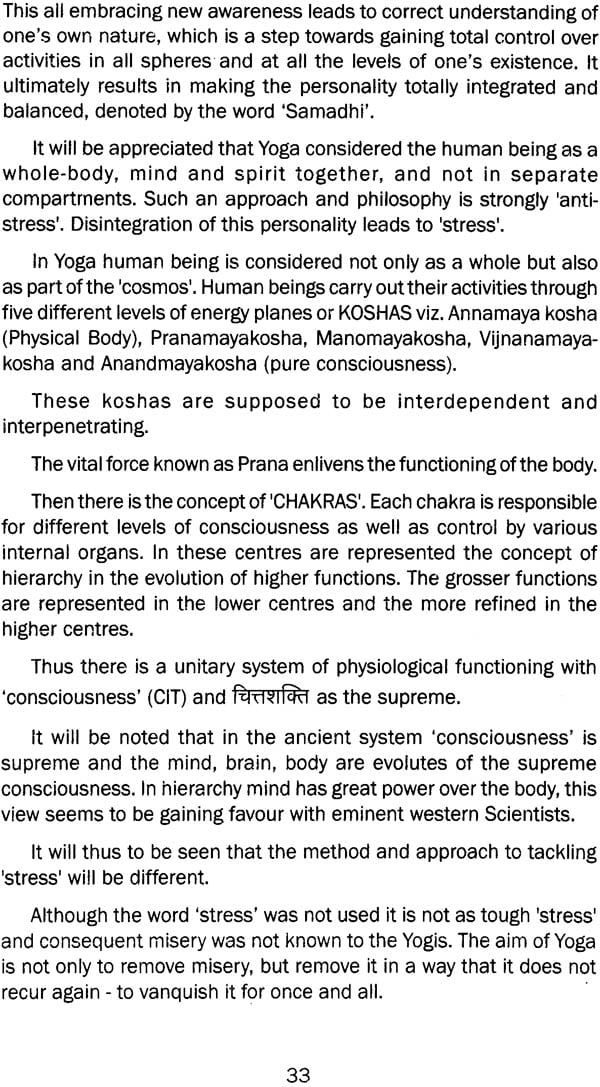
Living with Stress without Distress Through Yoga (Stress Management Modern and Yogic Perspective)
Book Specification
| Item Code: | NAH038 |
| Author: | Dr. Shrikrishna and Dr. M.V. Rajapurkar |
| Publisher: | Kaivalyadhama Samiti Lonavla |
| Language: | English |
| ISBN: | 8189485156 |
| Pages: | 39 (29 B/W Illustrations) |
| Cover: | Paperback |
| Other Details | 8.5 inch X 5.5 inch |
| Weight | 60 gm |
Book Description
The concept of stress is as elusive as it is important. Stress is ubiquitous. No person escapes of some sort or the other in daily life. In this sense people are seen as passive helpless victims of the stress phenomenon. In a sense it is a new generic term for ‘cause-effect’ relationships.
The aim of every human being is to survive as happily as possible, in an ever changing world and to achieve the highest possible consistent with one’s potentialities. It is the gap between achievement and expectation that leads to stress. For the present concept of stress we owe a great dealt to the pioneering work of Prof. Hans Selye, who was awarded the Nobel Prize for this work.
What is Stress?
(a) Definition:
Stress is now formalized to mean –any change within a system induced by external forces. Stress is a demand on our adaptability to evoke a response. In a fast changing world the demands on human adaptability are great and hence, changes of stress being produced are greatly enhanced.
(b) Selye’s Concept:
Prof. Selye noted that animals exposed to a wide variety of noxious agents, underwent a somewhat ‘stereotypic patterns’ of physiological changes. In this sense they were ‘non-specific’. He designated this response pattern as ‘General Adaptation Syndrome’ (GAS) and the stimuli that provoke the syndrome were called ‘stresses’ or ‘stressors’. Derailment of GAS produces ‘diseases of adaptation’. In GAS the bodily physiological responses evolve in three stages:
(a) The ‘alarm reaction’
(b) The ‘stage of resistance’
(c) The ‘stage of exhaustion’ –implies a decline of defence reactions.
It would be borne in mind that the outcome of GAS is to some extent influenced by the specific nature of the demanding agent. In addition certain factors not connected with stress modify the pattern of GAS. Such factors are: heredity, diet, pre-existing disease of certain organ systems etc. these are called ‘conditioning factors’.
The defence against stress occurs in two phases. Initially the stressor evokes by way of the hvpothalamus a strong ‘sympathoadrenal discharge’. The release of stored catecholamines produces their characteristic cardio vascular and metabolic reactions e.g. rapid heart rate, raise in blood pressure, increase in blood sugar level etc. If the stress is not severe of is of short duration this may restore to normality.
If the stress is sever and long lasting additional defence reactions are called into play. There is a release of cortico-steroids from the adrenal cortex, mediated through the hypothalamus, leading to increased liberation of ACTH and a shift in the balance of pituitary hormones. It is now believed that besides the hypothalamus the limbic and reticular system also come into play to organize the resistive response.
Thus, there is a psychic and emotional contribution in the initiation to stress response and consequent compensatory adjustments. The automatic nervous system (ANS) also plays an important part in expression of emotion as evidenced by blanching or flushing of the skin, cardiae acceleration, papillary dilation, piloerection, sweating etc.
To summarize then it may be said that ‘stress’ acts on the organism producing GAS –which acts on the ‘Target Organ’. If the stress is long lasting or severe, adaptation is derailed and psychic or somatic disease results.
Conditioning factors modify the stress response.
Two important contributions accrue from Selye’s work.
(a) The understanding of mechanism of stress and that of the defence to stress is through the Nervous mechanism and hormonal defence. Conditioning factors also determine the outcome of stress.
(b) There exist a large number of diseases whose causation we do not comprehend or comprehend but dimly. These are what Selye likes to call ‘Disease of Adaptation’ and may include disorders of psycho-somatic origin. The list is polymorphic. To quote a few: ulcerative colitis, peptic ulcer, rheumatic disease, hypertension, asthma, arthritis, cardiac disorders, depression etc. may be produced by maladaptation.
Stressors
Having reviewed briefly Selye’s work it is essential to understand stressors and how they related to the outcome of stress.
Stressors may be:
(a) Psychological: e.g. loss of love, academic failure, unconscious conflict, death of a near one etc.
(b) Cultural: e.g. social deprivation.
(c) Economic: e.g. unemployment, poverty etc.
(d) Physiological: e.g. bacteriological or physical chemical injury.
Besides these in a rapidly changing world the human being has to adapt to unprecedented challenges. Travel is changing unimaginably. A visit to the moon is possible. Nuclear power, nuclear weapons, genetic engineering, and other research achievements, may leap ahead of our biological ability to adapt.
Besides this there are many minor daily hassles which produce stress. Common events like traffic jams, foul-ups at work, unsympathetic boss, arguments, losing or misplacing things (like car keys, glasses), concern about weight gain, rising prices and many other problems.
Earlier also human beings suffered stress. The ‘cave man was afraid of attack by wid animals or dying of hunger, cold or exhaustion. The reaction was simple –‘Flight or Flight.
Today the stress situations are highly complex like, crash of stock market, world war, environmental pollution, over which the individual has no control and the simple ‘Fight or Flight’ reaction is no longer the answer.
Man has acquired a brain complex, sense of logic, ethics, a philosophy and these control his impulses and help him to choose consciously how to respond to the demands of life and to the various stressors.
| 1 | Yoga As a Science of Health and Healing | 5 |
| 2 | Three Components of Yogic Approach | 6 |
| 3 | What is "Stress"? | 8 |
| 4 | Factors Which Influence The Feeling of Stress | 9 |
| 5 | Warning Signals of Stress | 9 |
| 6 | Physical Effects of Stress | 10 |
| 7 | Personality and Vulnerability to Stress | 10 |
| 8 | How to Deal with The Stress: | 12 |
| Management of Perception | ||
| Management of Time | ||
| Management of Health Status | ||
| (A) Rest, Recreation and Relaxation | ||
| (B) Exercise and Body Management | ||
| (C) Diet | ||
| 9 | Some Important Considerations in The Practical Programme of Yoga | 15 |
| 10 | Rules to Be Observed During the Performance of Asanas, Pranayama and Meditational Practices | 17 |
| 11 | Some General Useful Hints | 18 |
| 12 | Yogic Programme Taught in The Arogyasharanam Workshop: | |
| (A) The General Approach | 19 | |
| (B) Process of Inner Awareness | 19 | |
| (C) Movements and Asanas | 21 | |
| (D) Breathing and Pranayama | 25 | |
| (E) Meditative State and Inner Silence | 25 | |
| 1 | Introduction | 29 |
| 2 | Perception and Stress | 32 |
| 3 | Yoga and Stress | 32 |
| 4 | Stressors | 34 |
| 5 | Experimental Evidence | 36 |
| 6 | Bibliography | 39 |









